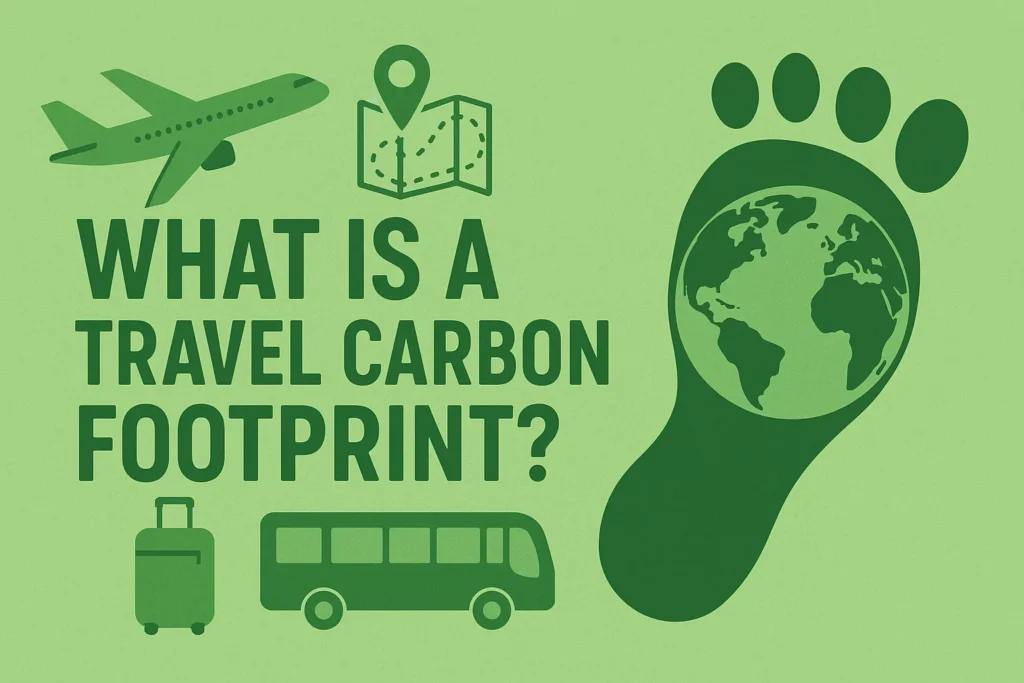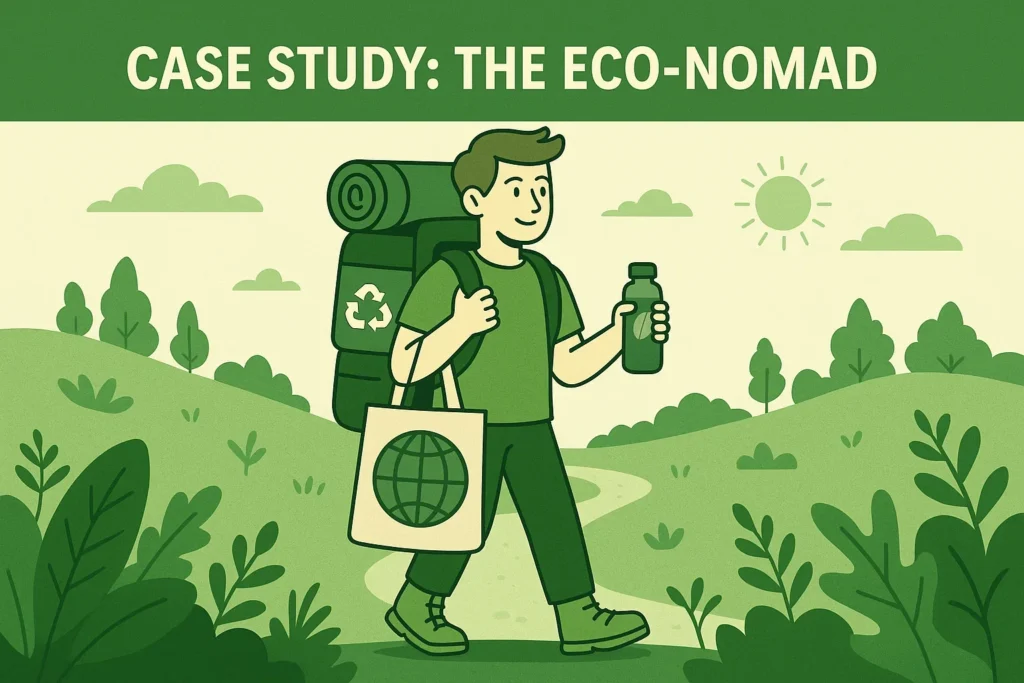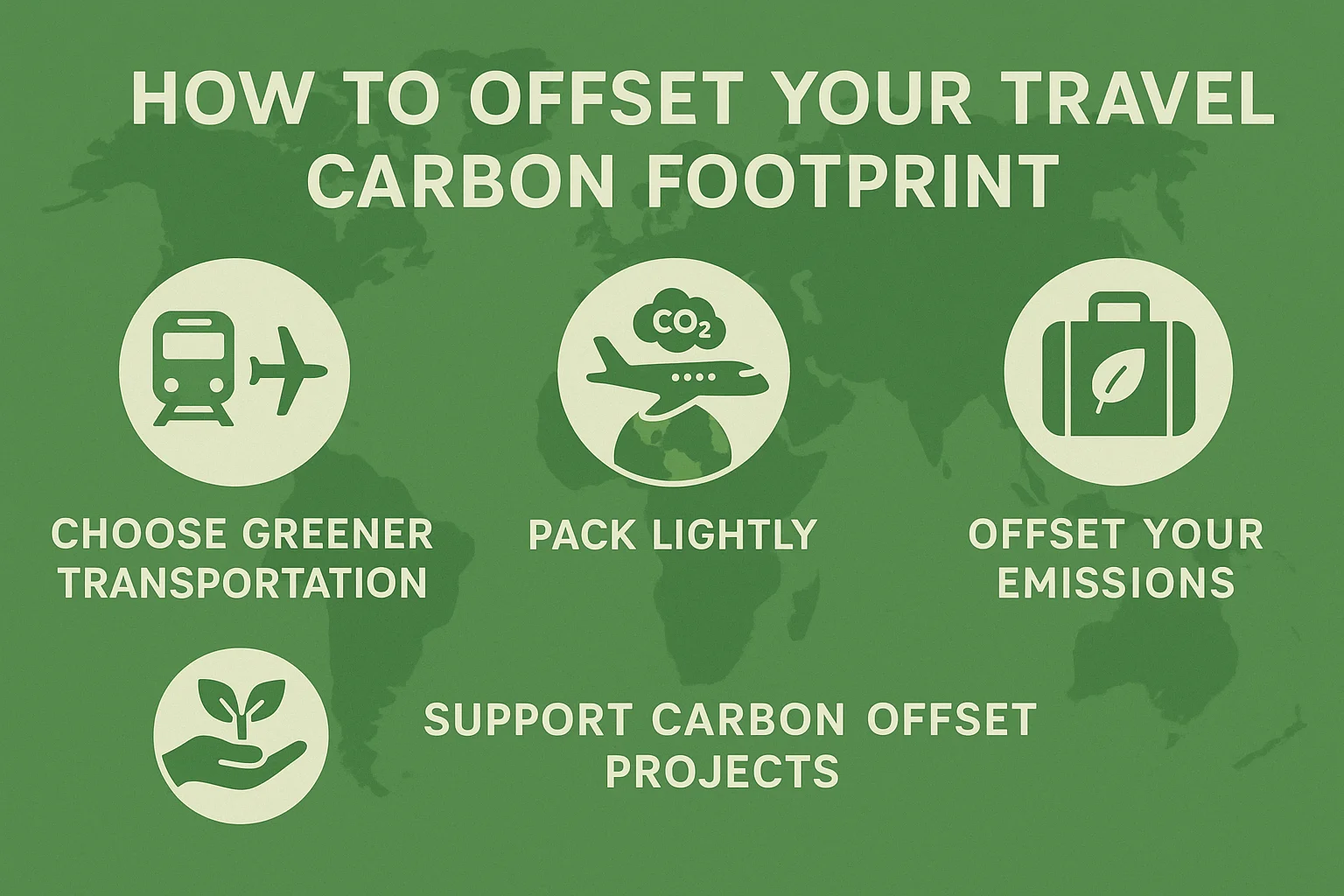Travel is part of human nature. We seek new cultures, experiences, and landscapes. Yet each trip comes with a cost — carbon emissions. A single long-haul flight can undo months of eco-friendly living. The good news is you don’t need to cancel your trips; you need to make them smarter.
This guide explains how to offset your travel carbon footprint using practical, tested strategies. You’ll learn from real traveler stories, see data-backed comparisons, and discover how platforms like Eco Gear Guides can help you pack lighter and more sustainably.
What Is a Travel Carbon Footprint?

Your travel carbon footprint is the sum of greenhouse gases released by your travel activities. It’s more than just flights. It includes:
- Transport: flights, car rentals, buses, or trains.
- Accommodation: energy use in hotels or resorts.
- Food choices: imported meals vs. local produce.
- Souvenirs: shipping and manufacturing emissions.
To put it in perspective:
- A round-trip flight from New York to Paris = 2,000 kg of CO₂, equal to charging 250,000 smartphones.
- Driving 1,000 miles = 240 kg of CO₂, or about 27 gallons of gasoline burned.
- A week-long cruise = as much CO₂ as heating a home for an entire year.
Clearly, small choices add up fast.
Why Carbon Offsetting Matters
Carbon offsets don’t erase emissions but they balance them. By funding projects that remove or prevent CO₂ release, you compensate for what you can’t directly cut.
Offsets matter because they:
- Protect ecosystems like forests and coral reefs.
- Support communities through clean stoves, solar panels, and water systems.
- Preserve travel itself, as climate change threatens destinations worldwide.
Practical Steps to Offset Your Travel Carbon Footprint
1. Pick Smarter Transport
Transport is often the largest share of your footprint. Here’s a clear example:
- Berlin to Amsterdam by plane = 410 kg CO₂
- Berlin to Amsterdam by train = 30 kg CO₂
That’s the difference between eating one cheeseburger and 13 family-sized pizzas.
If you must fly:
- Select non-stop flights to reduce fuel-heavy takeoffs.
- Choose airlines with modern, fuel-efficient fleets.
- Book economy — more passengers per plane equals lower emissions per person.
2. Calculate Before You Compensate
Always calculate your footprint before buying offsets. Tools like MyClimate and Gold Standard provide trip-specific estimates.
Offset Provider | Focus | Example Project
- Gold Standard | Energy & Reforestation | Cookstoves in Ghana
- Cool Effect | Community Projects | Methane capture in Montana cattle farms
- MyClimate | Travel-Specific | Biogas systems for Nepalese families
💡 Traveler Story: A couple flying from Chicago to Tokyo used Cool Effect and offset their flight for just $28. Their emissions equaled burning 1,000 pounds of coal — now neutralized.
👉 Read More: Best Sustainable Luggage Brands for Green Travel
3. Book Eco-Friendly Accommodation
Hotels can generate large emissions. Reduce impact by choosing:
- Properties using solar or wind energy.
- Stays offering bulk toiletries instead of single-use plastic.
- Certified eco-hotels such as EarthCheck or Green Key hotels.
4. Pack Light and Smart
Few travelers realize that luggage weight matters. Every extra 10 kg on a long-haul flight = 60 kg CO₂. That’s the same as leaving a 60-watt light bulb on for 100 days.
How to reduce weight:
- Use multi-purpose clothing (convertible jackets, travel pants).
- Carry reusable bottles, bamboo cutlery, and solar chargers.
- Check platforms like Eco Gear Guides for sustainable, lightweight gear.
5. Plan Sustainable Activities
Your activities on the ground also shape your footprint. Choose wisely:
- Dine in local restaurants serving regional food.
- Avoid fuel-heavy tours such as jet skis, which consume as much fuel in one hour as a car in a week.
- Join eco-volunteering programs such as tree planting or beach cleanups.
Traditional Travel vs. Conscious Travel
| Aspect | Traditional Traveler | Conscious Traveler |
|---|---|---|
| Transport | Multi-stop flights | Non-stop flights or trains |
| Luggage | Overpacked, plastics | Light, eco gear |
| Stay | Chain hotels | Eco-certified properties |
| Activities | Cruises, mass tours | Eco-volunteering, cultural immersion |
| Offsetting | None | Verified projects (Gold Standard, MyClimate, Cool Effect) |
Case Study: The Eco-Nomad

Meet Rina, a digital nomad from Singapore. On a three-month European journey:
- She replaced budget flights with trains for short distance.
- Offset long-haul flights via Gold Standard, funding reforestation in Tanzania.
- Carried a foldable solar charger and stainless steel bottle from Eco Gear Guides.
- Volunteered in Spain, planting olive trees with a local NGO.
Her emissions were 46% lower than an average traveler following the same route.
Conclusion
Travel doesn’t need to harm the planet. By making smarter choices — from transport and accommodation to luggage and activities — you can significantly reduce your footprint. For the emissions you can’t avoid, certified offsets provide balance.
So next time you think about how to offset your travel carbon footprint, remember: small actions like flying direct, packing light, or booking a green hotel add up. And when in doubt, platforms like Eco Gear Guides guide you toward products that help you travel lighter and smarter.
👉 Read More: Eco-Friendly Camping Gear for Nature Lovers
FAQs on Travel Carbon Offsetting
1. Is offsetting enough on its own?
No. Always reduce emissions first, then offset the rest.
2. How expensive is offsetting?
Not much — a round-trip transatlantic flight may cost $20–30 to offset.
3. What’s the easiest step for beginners?
Pack lighter and carry reusables. It’s a quick way to cut CO₂.
4. Do eco-hotels really matter?
Yes. Certified hotels using renewables can cut their emissions in half compared to standard hotels.
5. Can Eco Gear Guides help?
Yes. They provide reliable reviews of eco-friendly gear, making sustainable packing easier.


